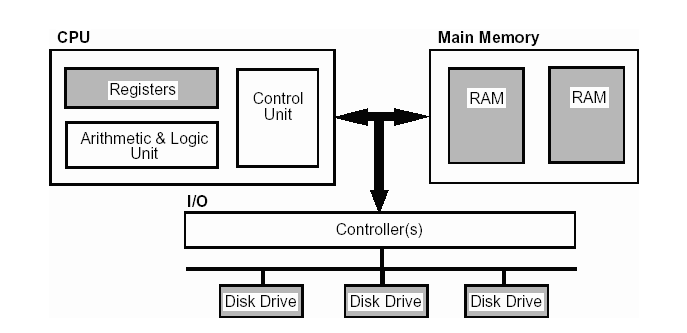What Is Register?
A processor register also referred to as CPU register or simply register, is a small set of data holding places that are part of the computer processor. A register may hold an instruction, a storage address or any kind of data such as a bit sequence or individual characters. Some instructions specify registers as part of the instruction. For example, an instruction may specify that the contents of two defined registers be added together and then placed in a specified register.
There are several types of registers used for various purposes. Some of the commonly used registers are:
- Accumulator
- Data register
- Address register
- Program counter
- Memory data register
- Index register
- Memory buffer register
What You Need To Know About Memory
- Registers are located inside the CPU.
- Data has to be loaded into a CPU register from memory before the CPU can process it.
- Register holds small amount of data.
- Data storage capacity of register ranges between 32-bits to 64-bits.
- CPU can operate on the register at a very much faster rate when compared to memory (the rate is more than one operation in one clock).
- Registers are smallest data holding elements that are built into the processor itself.
- Registers hold the operands or instruction that CPU is currently processing.
- Types of registers include: Accumulator register, Program counter, Instruction Register, Address Register etc.

What Is Memory?
Memory is any physical device capable of storing information temporarily like RAM (random access memory) or permanently like ROM (read only memory). Memory devices utilize interpreted circuits and are used by operating systems, software and hardware.
Memory is usually classified as either volatile or non-volatile. Volatile memory is memory that loses its contents when the computer or hardware device loses power. RAM (random access memory) is an example of volatile memory. Non-volatile memory on the other hand is the memory that keeps its contents even if power gets lost. EPROM is an example of non-volatile memory.
What You Need To Know About Registers
- Memory or RAM is located external to the CPU.
- Data has to be loaded into a CPU memory after register the CPU can process it.
- Memory stores the large amount of data than register.
- Data storage capacity of memory ranges between Gigabyte (GB) to Terabyte (TB).
- CPU accesses memory at the slower rate than registers.
- Memory is the largest data holding element that is built external to the processor itself.
- Memory holds the instructions and the data that the currently executing program in CPU requires.
- RAM is the main memory of the computer. Though memory are usually classified as either volatile or non-volatile.
Also Read: Difference Between Uniform Memory Access And Non-Uniform Memory Access
Different Between Memory And Registers In Tabular Form
| BASIS OF COMPARISON | REGISTERS | MEMORY |
| Description | Registers are smallest data holding elements that are built into the processor itself. | Memory is the largest data holding element that is built external to the processor itself. |
| Location | Registers are located inside the CPU. | Memory or RAM is located external to the CPU. |
| Data Loading | Data has to be loaded into a CPU register from memory before the CPU can process it. | Data has to be loaded into a CPU memory after register the CPU can process it. |
| Data Storage | Register holds small amount of data. | Memory stores the large amount of data than register. |
| Data Storage Capacity | Data storage capacity of register ranges between 32-bits to 64-bits. | Data storage capacity of memory ranges between Gigabyte (GB) to Terabyte (TB). |
| CPU Speed | CPU can operate on the register at a very much faster rate when compared to memory (the rate is more than one operation in one clock). | CPU accesses memory at the slower rate than registers. |
| Function | Registers hold the operands or instruction that CPU is currently processing. | Memory holds the instructions and the data that the currently executing program in CPU requires. |
| Types | Types of registers include: Accumulator register, Program counter, Instruction Register, Address Register etc. | Random Access Memory (RAM) Read only memory (ROM) |
Also Read: Difference Between Optical Disk And Magnetic Disk